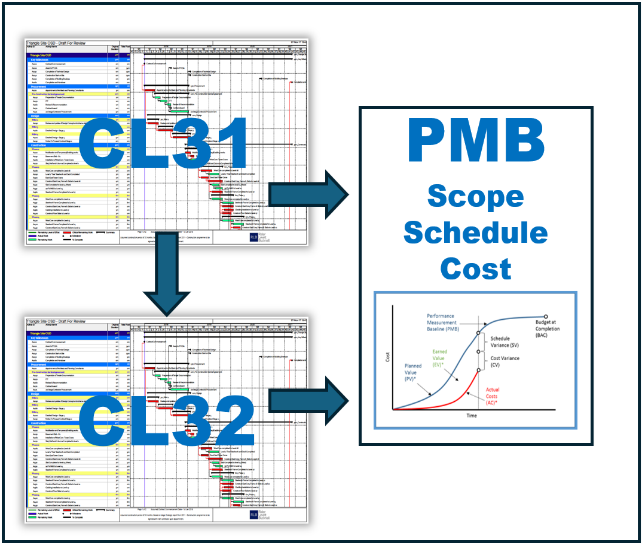
The NEC family of contracts continues to be a popular choice in UK infrastructure and construction sectors due to its collaborative and proactive management ethos. Project controls, when properly implemented, are a fundamental enabler of this ethos. They provide the data, systems and structure necessary to support contractual compliance, transparency and early intervention.
What Are Project Controls? Project controls refer to the data-driven disciplines such as cost management, time planning, risk management, change control, and performance reporting. These processes are critical for measuring performance against planned baselines, informing decision-making and providing warnings when projects deviate from their expected path. Within the NEC framework, project controls directly support contractual compliance and enable proactive project management.
NEC Principles and Project Controls are a natural alignment: The NEC contracts are underpinned by principles of clarity, simplicity, proactive management, collaboration and early warning mechanisms. Project controls naturally align with these principles, ensuring transparent and structured communication and enabling accurate and timely responses to project change/risk.

What would be the baseline? There are two potential baselines that will be used in relation to the project programme.
- The NEC Accepted Programme (contractual baseline), as defined under clause 11.2(1) of the ECC, represents the official time baseline for the project. As prescribed in clauses 31.2 and 32.1, this programme (schedule) must be realistic, achievable and regularly updated to reflect current project status. Project controls tools such as Primavera P6 or Microsoft Project can help manage complex schedules, but it is essential that any internal planning or tracking reflects what has been submitted and accepted under the contract to avoid conflicts. The NEC Accepted Programme therefore becomes the baseline from which to measure future progress and change against.
- Performance Measurement Baselines (PMB’s) integrate the projects scope, schedule and cost into a single reference point against which project performance is measured. Earned Value Management, or EVM, is a method commonly used to monitor this performance. Although NEC does not specifically reference EVM, it can be applied effectively if aligned with the Accepted Programme and the contracts Defined Cost structures. Project teams should ensure the EVM time baseline reflects the Accepted Programme and that cost breakdowns align with the Fee structure to avoid contradictions. This is a different baseline to the one used to specifically assess compensation events.
Compensation Events and Change Control: NEC contracts manage change through the Compensation Event process. Project controls are essential in ensuring changes are identified promptly, correctly quantified, and integrated into the updated programme. Forensic schedule techniques, such as Time Impact Analysis, help substantiate time impacts using the latest Accepted Programme as a reference point. The recently updated clause 63.5 now makes it clearer the fact that progress and other compensation events since the last Accepted Programme should be considered first, before assessing the impact of any new compensation event (see previous CECA bulletin 18)
Early Warning and Risk Registers: The early warning process within NEC contracts is designed to proactively highlight and address risks. Project controls teams contribute by maintaining live early warning registers and risk registers using tools such as Excel, Active Risk Manager or Primavera Risk Analysis. These registers are regularly updated through risk workshops and quantitative assessments, helping teams to forecast cost and time impacts and mitigate issues before they materialise. Set up correctly, good project controls can turn the NEC Early Warning Meeting into a fully-fledged risk review meeting limit or avoid the need for two separate meetings.
Cost Control and Payment: In NEC contracts, particularly under target cost options, it is vital that actual Defined Costs are accurately recorded and clearly traceable. Project controls play a central role by ensuring detailed cost data is captured in real time, coded consistently, and synchronised with monthly payment applications. A particularly effective approach is the use of cost-loaded programmes, where planned activities are assigned values that correlate with work progress and earned cost. This method enables payment applications to be prepared more efficiently and in a manner that is directly aligned with the Accepted Programme, reducing the risk of disputes over valuation or entitlement. Cost-loaded programmes also support better forecasting of outturn cost and facilitate performance monitoring against both time and budget. Commercial & contract management tools such as Think Project Contract, Oracle Primavera Unifier, or COINS can help bridge the gap between operational delivery, commercial administration, and NEC payment mechanisms. However, to maximise their effectiveness, it is essential that all cost reporting and forecasting remains compliant with NEC’s definitions of Defined Cost, Fee, and Payment Due Date rules, and that these tools are configured accordingly to avoid misalignment or misinterpretation of entitlement.
Reporting, Dashboards and Governance: Reporting is the vehicle through which performance insights are communicated, enabling stakeholders at all levels to make informed, timely decisions. Dashboards and visual reports built in tools such as Power BI or Tableau offer powerful ways to present key project data—covering schedule, cost, risk, change control, and progress—in an intuitive and accessible format. However, these reports are only as reliable as the data on which they are built. To ensure consistency and accuracy, it is critical that all reporting is driven by a centralised data lake, where validated, source-aligned information from planning tools, cost systems, and site records is collected, structured, and maintained. A tiered reporting structure should then be implemented, providing different views for different audiences: operational detail for site teams, contract-aligned performance summaries for commercial leads, and high-level dashboards for Client and executive stakeholders. This layered approach avoids duplication, reduces reporting fatigue, and ensures that decision-makers are looking at the same version of truth—fully aligned with contractual requirements, including the Accepted Programme and Defined Cost structures. By investing in structured data architecture and reporting governance, project teams can turn project controls into a powerful enabler of NEC compliance and performance assurance.

Z Clauses and the Risk to Project Controls Alignment: While the NEC contract is designed to encourage good project management and collaborative behaviours, the addition of Z clauses (client-drafted amendments) to the standard contract can undermine this intent. Z clauses often introduce bespoke processes, payment terms, or reporting requirements that diverge from the original contract framework. From a project controls perspective, this can create significant confusion and misalignment. For example, if a Z clause alters the rules around programme submission, payment timelines, or the evaluation of compensation events, it may lead to conflicting baselines, mismatched performance metrics, and delays in decision-making. These amendments can erode the clarity and transparency NEC seeks to provide and make it more difficult for project controls teams to maintain consistent, contract-compliant data. It is therefore essential that project teams carefully review and understand all Z clauses at the outset and ensure that any project controls systems and procedures are adapted accordingly, without losing alignment with the core NEC obligations.
Common Pitfalls and Practical Recommendations: Some of the frequent issues observed on NEC projects include:
- creating internal schedules or cost baselines that diverge from the Accepted Programme
- not updating the Accepted Programme promptly for compensation events
- using EVM metrics without linking them to NEC assessments
- misinterpreting risk-based allowances as contractual entitlements
To avoid these pitfalls:
- integrate contract and project controls teams early in mobilisation
- build performance baselines from the NEC programme and cost data
- use project controls tools as enablers—not replacements—of contract compliance
- maintain transparency of assumptions and data sources in all reporting
Summary: Project controls are not simply support functions—they are integral to the successful delivery of projects under the NEC contract. When implemented effectively, project controls bring structure, clarity, and predictability to complex programmes of work. They enable all parties to proactively manage time, cost, risk, and change while remaining compliant with the contract.
Central to this success is ensuring that project controls processes, tools, and reporting frameworks are built around the core NEC principles—particularly the requirement for an Accepted Programme, Defined Cost, and transparent early warning mechanisms. Tools such as cost-loaded programmes, tiered reporting structures, and integrated data lakes can add significant value when configured to align with contract requirements.
However, it is equally important to recognise and manage the potential risks introduced by bespoke Z clause amendments, which may create misalignment between commercial expectations and project controls data. These risks can lead to increased administrative burden, reporting confusion, and ultimately, disputes.
By investing in robust, contract-aligned project controls infrastructure and fostering a culture of collaboration between delivery, commercial and controls teams, NEC projects can not only comply with the letter of the contract—but deliver on its intent: better managed, better governed, and more successful project outcomes.
Whilst the intent of the bulletin highlights the need to align and link project controls to the NEC contract, the magnitude and intensity of these activities it must be recognised that they remain appropriate for the size and complexity of a project.

